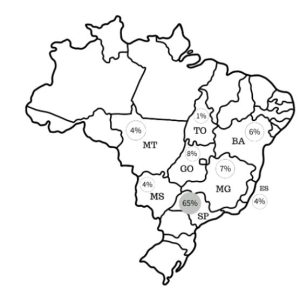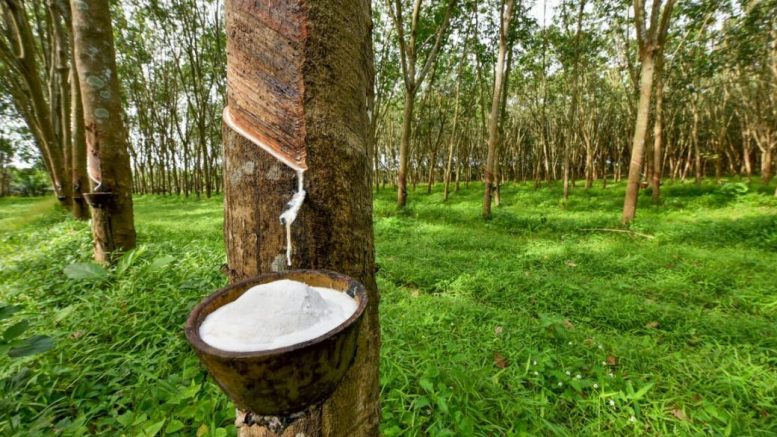“What exists is an already reduced supply of rubber, and there is no way to reverse this situation.”
José Fernando Canuto Benesi is the president of the Association of Natural Rubber Farmers of the States of Goiás and Tocantins – APROB-GO/TO and Director at Hevea Suporte. Benesi holds a degree in Agricultural Engineering from the São Paulo State University Júlio de Mesquita Filho.
AgriBrasilis – Why is Brazil not self-sufficient in rubber?
Benesi – The rubber tree (Hevea brasiliensis) is native to Brazil, yet the country is not self-sufficient in rubber production, importing 60% of its consumption. In the past, we were the world’s sole farmers, but today Brazil rely on imports. The decline of national production stems from historical factors such as the lack of public policies, agronomic challenges, and the smuggling of seeds by the British. Between 1879 and 1912, during the Rubber Boom, Amazon led the global market, exporting to the U.S. and Europe. Manaus flourished, as reflected in the construction of the Amazon Theatre.
In 1876, Henry Wickham took seeds to British Asian colonies, where research and advanced techniques increased productivity. By 1912, Asian rubber dominated the market, making Brazil an importer by 1940. Attempts to cultivate rubber in the State of Bahia failed due to fungal diseases, leading to the abandonment of rubber farms. In the 1970s, the State of São Paulo successfully implemented large-scale rubber cultivation, expanding it to other states in the following decade. Rubber is a strategic commodity, but insufficient government programs maintain our external dependence. To achieve self-sufficiency, an additional 300,000 hectares of rubber trees would be required.
AgriBrasilis – How can rubber tree productivity be increased?
Benesi – The productivity of rubber trees depends on various factors, from planting to tapping, which involves cutting the tree’s bark to extract latex. Establishing a rubber farm requires a detailed analysis of climate, soil, spacing, fertilization, pest and disease control, and most importantly, clone selection. The most widely cultivated clone globally is RRIM 600, developed in Malaysia. However, an Embrapa study in Goianésia, in the State of Goiás, evaluated 72 clones and selected 10 with productivity up to 40% higher than RRIM 600, some already being used commercially.
Once production begins, tapping efficiency is critical for productivity, making the management an essential factor. Elements such as the adopted tapping system, task size, cut depth and width, tree injuries, and advancement towards secondary latex vessels directly impact yields. Additionally, production losses, cut slope, proper stimulation, pest and disease control, panel dryness prevention, proper equipment cleaning, panel balancing, an annual rest period, and efficient plantation management are all key to ensuring sustainable and profitable production.
AgriBrasilis – Is Brazilian production overcoming the crise of recent years?
Benesi – The Brazilian rubber industry has a positive medium and long-term outlook and has shown a strong recovery since the beginning of the 2024/2025 season in September 2024. However, with the trade war triggered by the U.S., the scenario is somewhat uncertain at the moment, and we cannot yet predict a definitive return to the sector’s competitiveness.
Nevertheless, the fundamentals are strong because rubber farmers worldwide have refrained from planting new plantations for a long time, and the existing are aging with low productivity. Thus, any increase in demand, or even a normalization of market supply and consumption, will create a supply shortage, leading to greater demand. Rubber will be in short supply, and prices will remain favorable for the next five years. At the moment, due to this looming trade war disrupting demand, we cannot predict this scenario with greater accuracy. What exists is an already reduced rubber supply, and there is no way to reverse this situation.
“Rubber prices have risen due to demand outpacing supply…”
AgriBrasilis – What factors are driving price increases?
Benesi – Rubber prices have risen due to demand outpacing supply. Additionally, excessive rainfall during the last season in the largest production region — Asia — and the appreciation of the U.S. dollar against the Brazilian Real (BRL) have contributed to the rising price of natural rubber in Brazil.
AgriBrasilis – Is there a mismatch between global supply and demand? Why?
Benesi – There is a supply-demand imbalance for two very important reasons. First, since rubber is a perennial crop, market cycles involve long periods of high and low prices. When demand increases, it takes around ten years for new plants to respond. Likewise, when there is an oversupply, it also takes time to balance the market. It is not feasible for an investor who has committed to a 50-year rubber farm to suddenly remove it due to a temporary price fluctuation. However, there is something very important to highlight about supply and demand in this sector: our market is imbalanced!
The rubber industry does not function as a natural economic market because, when prices drop, this movement should discourage production, leading to lower supply and price recovery. Yet, this does not happen in the rubber sector. When the price of natural rubber falls, the main producing countries in Asia (Thailand, Indonesia, and Vietnam) continue to buy production and maintain a minimum price, keeping supply steady even when the market is unfavorable. This practice causes prices to drop even further than they should, instead of simply adjusting supply and allowing prices to recover. In summary, when prices fall, supply is maintained, stockpiles grow, and prices fall even more, creating a cycle that hampers healthy market development. However, after years of dealing with this issue, major Asian farmers have begun gradually replacing natural rubber production with oil palm and other activities, reducing the global supply of natural rubber.
AgriBrasilis – Where is Brazilian rubber cultivation concentrated? How do different production systems compare?
Benesi – The State of São Paulo’s production system is based on “partnership”, where tappers have a partnership contract with rubber farms owners, receiving between 40% and 50% of production while being responsible for all labor. In the 2023/2024 season, with low prices, many of these partners abandoned the sector. This situation was worsened by labor shortages across all agricultural sectors, leading to the estimated eradication of nearly 30% of São Paulo’s rubber farms — a process that is still ongoing.
In the States of Minas Gerais, Mato Grosso do Sul, Mato Grosso, and Espírito Santo, there is a mix of partnership and formal employment (CLT) systems. In Goiás and Tocantins, the CLT system is preferred.
In practice, we have observed that these different hiring methods lead to significant productivity variations. In the partnership model, the owner has little influence over the tapper’s work system to avoid creating an employer-employee relationship. As a result, productivity hovers around 1,500 kg per hectare of dry rubber. In contrast, in the States of Goiás and Tocantins, where tappers are directly managed under the CLT system with more oversight and guidance, productivity surpasses 2,000 kg of dry rubber per hectare.

Rubber production map in Brazil. Source: José Benesi.
READ MORE:

